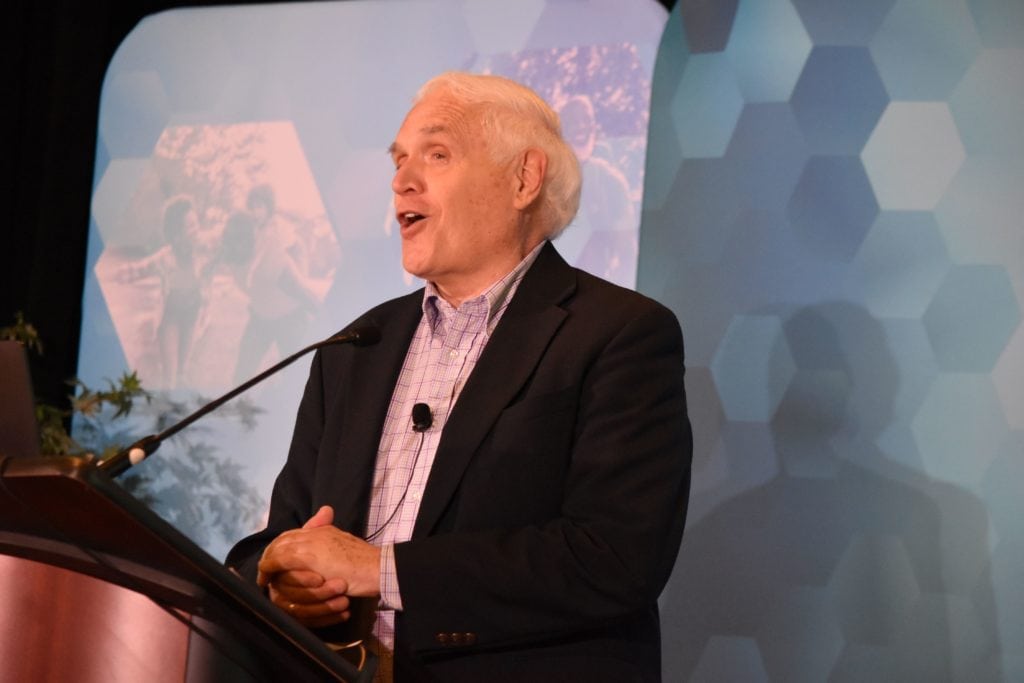
An April 5 presentation at the Health Summit of the North American Division of the Seventh-day Adventist Church in Lexington, Kentucky, United States, shed light on the context in which the Adventist health message emerged and discussed the church’s efforts to fight alcohol and other drugs. Keynote speakers were Duane McBride and Alina Baltazar, a father-daughter duo of experienced researchers on the topic.
In their 90-minute presentation, they also reviewed current programs the church directs toward policy, prevention, and recovery, and shared best prevention practices that local churches can implement to fight the scourge.
It was first McBride’s turn to provide background on the world in which the Adventist Church was born. “The Declaration of Independence [of the United States] was written in a tavern, not a church,” McBride reminded Adventist health leaders and advocates. “And the first coffee break was a coca break.” The latter statement refers to the 19th-century habit of using cocaine, which was widely available.
It is also a topic of personal interest, McBride said as he shared how alcoholism destroyed his mother’s extended family until she became a Seventh-day Adventist.
In U.S. History
Puritans were opposed to drunkenness but not to alcohol, McBride said. Also, during the Civil War, physicians used morphine to treat pain. After the war, many soldiers continued to use morphine, which was easily available.
The popular Sears catalog sold opiates (heroin) and syringes, claiming it was not addictive and relieved pain. “The Pope, Thomas Edison, and President McKinley endorsed coca wine,” McBride said. “It was advertised as helping you work hard, regardless of conditions, with no addictive properties.”
The consequences of such behaviors led to domestic violence, a wide variety of health issues, addictions, lost productivity, and poverty.
At the same time, since the late 18th century, various voices across the U.S. were warning against alcohol and drugs and advocating for temperance. Advocates organized societies and published journals to fight alcohol consumption.
The Adventist Church, Temperance, and Prohibition
Ellen G. White called temperance “her favorite subject,” which she discussed while speaking in Adventist and other Christian churches. She famously defined temperance as “[abstaining] entirely from that which is injurious, and [using] judiciously only healthful and nutritious articles of food,” McBride reminded health leaders.
White also encouraged every church member to get involved in an advocacy effort, McBride emphasized. White, he said, called every advocate to “exert their influence by precept and example … in favor of prohibition and total abstinence.”
McBride highlighted that White, however, did not stop at fighting the scourge but also focused on recovery efforts, helping people who had fallen prey and were enslaved by intemperance.




Alcohol Consumption Today
Most serious research studies agree that alcohol consumption has no health benefits, McBride and Baltazar said. They explained that “even in cases where researchers spoke about a supposed benefit, it was often shown that they had altered the measurement model to fit their conclusions.”
McBride and Baltazar added that “alcohol increases violence of all types, brain damage, cancer, and cardiac problems. Other proven consequences include more accidents, poverty, and divorce. And the total economic fallout of alcohol use disorder includes billions of US dollars in healthcare costs.”
What the Adventist Church Is Doing
Following its historical position, the Adventist Church has implemented multiple initiatives to discourage alcohol sale and consumption. At the same time, it has made a point of supporting those who are recovering addicts or feel the desire to be free from addictions.
These initiatives include the International Commission for the Prevention of Alcoholism and Drug Dependency, founded in 1952, which advocates policies restricting access. Others include Adventist Recovery Ministries and the Institute for Prevention of Addictions, the latter in partnership with Andrews University.
Research has proven to be a witness of the church’s efforts. Adventist scholars present papers and publish articles regularly on topics related to addictions and recovery. “An analysis of the online data shows that scientific publications by Adventist scholars on these topics are being read all around the world,” Baltazar said. “And the most-read topics include scientific research on faith and prevention, service and prevention, and alcohol as an unhealthy beverage.”
The Role of a Local Church
One of the summit participants, who defined himself as “a recovered addict,” asked McBride and Baltazar what local congregations can do to make sure the church’s message against addictions and its recovery efforts get beyond the sanctuary doors. “Our communities are hurting, and people don’t even know who Seventh-day Adventists are,” he said.
McBride and Baltazar agreed with him, as they emphasized that a local Adventist church can fulfill a key role to advance these ministries and initiatives.
“A local church can work to strengthen faith and families and support community services initiatives,” they said. “A congregation can also implement mentoring programs, provide trauma education, and sponsor recovery ministries. Its role is essential to connecting the church with the community and helping people be free from addictions.”